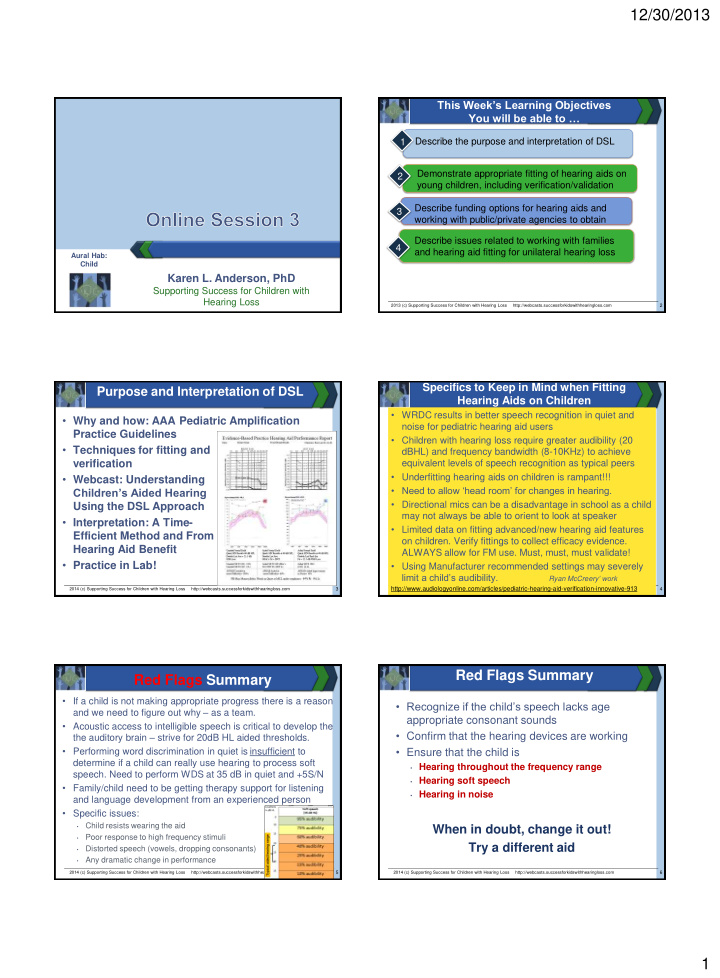



12/30/2013 This Week’s Learning Objectives You will be able to … Describe the purpose and interpretation of DSL 1 Demonstrate appropriate fitting of hearing aids on 2 young children, including verification/validation Describe funding options for hearing aids and 3 working with public/private agencies to obtain Describe issues related to working with families 4 and hearing aid fitting for unilateral hearing loss Aural Hab: Child Karen L. Anderson, PhD Supporting Success for Children with Hearing Loss 2013 (c) Supporting Success for Children with Hearing Loss http://webcasts.successforkidswithhearingloss.com 2 Specifics to Keep in Mind when Fitting Purpose and Interpretation of DSL Hearing Aids on Children • WRDC results in better speech recognition in quiet and • Why and how: AAA Pediatric Amplification noise for pediatric hearing aid users Practice Guidelines • Children with hearing loss require greater audibility (20 • Techniques for fitting and dBHL) and frequency bandwidth (8-10KHz) to achieve verification equivalent levels of speech recognition as typical peers • Underfitting hearing aids on children is rampant!!! • Webcast: Understanding • Need to allow ‘head room’ for changes in hearing. Children’s Aided Hearing • Directional mics can be a disadvantage in school as a child Using the DSL Approach may not always be able to orient to look at speaker • Interpretation: A Time- • Limited data on fitting advanced/new hearing aid features Efficient Method and From for Documenting on children. Verify fittings to collect efficacy evidence. Hearing Aid Benefit ALWAYS allow for FM use. Must, must, must validate! • Practice in Lab! • Using Manufacturer recommended settings may severely limit a child’s audibility. Ryan McCreery ’ work http://www.audiologyonline.com/articles/pediatric-hearing-aid-verification-innovative-913 2014 (c) Supporting Success for Children with Hearing Loss http://webcasts.successforkidswithhearingloss.com 3 4 Red Flags Summary Red Flags Summary • If a child is not making appropriate progress there is a reason • Recognize if the child’s speech lacks age and we need to figure out why – as a team. appropriate consonant sounds • Acoustic access to intelligible speech is critical to develop the • Confirm that the hearing devices are working the auditory brain – strive for 20dB HL aided thresholds. • Performing word discrimination in quiet is insufficient to • Ensure that the child is determine if a child can really use hearing to process soft • Hearing throughout the frequency range speech. Need to perform WDS at 35 dB in quiet and +5S/N • Hearing soft speech • Family/child need to be getting therapy support for listening • Hearing in noise and language development from an experienced person • Specific issues: Child resists wearing the aid • When in doubt, change it out! Poor response to high frequency stimuli • Try a different aid Distorted speech (vowels, dropping consonants) • Any dramatic change in performance • 2014 (c) Supporting Success for Children with Hearing Loss http://webcasts.successforkidswithhearingloss.com 5 2014 (c) Supporting Success for Children with Hearing Loss http://webcasts.successforkidswithhearingloss.com 6 1
12/30/2013 The Ling Quick Check! Model of Child Aural Habilitation Assessment • Commonly used to check for speech perception • Define the impact of the hearing loss on life function Close and distant, no visual cues • A gross check – not really enough to assume clear Under what situations is the child’s ability to function impaired? perception of all consonant sounds - VALIDATION When/how will participation be restricted? Talk about abilities not dB Personal Factors – Skills Environmental Factors - Language - Speech perception under use/communication varying conditions - Socialization skills - Ability to attend / fatigue - Psychosocial/self-concept - Speechreading benefit - Additional Learning - Accommodations currently Challenges in various environments 2014 (c) Supporting Success for Children with Hearing Loss http://webcasts.successforkidswithhearingloss.com 7 2014 (c) Supporting Success for Children with Hearing Loss http://webcasts.successforkidswithhearingloss.com 8 Interpreting Errors – Validation! Iowa Medial Consonant Test • Worth the time! Doing Look for a pattern in the Ling sounds and the errors. WDS testing does Consider NOT inform you as to the formant the completeness of relationships the child’s speech Adjust the perception. aid program • Administer the sounds frequency response as from 10 feet to a needed for friend wearing 100% earplugs. How long correct. did it take to do? 2014 (c) Supporting Success for Children with Hearing Loss http://webcasts.successforkidswithhearingloss.com 9 2014 (c) Supporting Success for Children with Hearing Loss http://webcasts.successforkidswithhearingloss.com 10 Make It Yours The Necessity for Teaming From Educators (DHH teachers, ed auds, SLPs): You have a patient • “His new hearing aids aren’t letting him repeat all the Ling with a moderate to Sounds and he is getting frustrated in school. We’ve collected severe hearing loss performance data and showed it to Mom. She allowed me to who will be starting call the audiologists but the audiologist says the aids are set preschool (age 4) correctly and the audiologist seemed angry at the data we that you haven’t were sharing. Mom feels overwhelmed at idea of confronting seen for 6 months. the audiologist.” Her speech still • “When we went to put the FM on her we found out that the sounds ‘mushy’ and audiologist selected hearing aids without the option for FM. isn’t easy to always Now we will have to provide school hearing aids and FM so she loses out on consistent hearing throughout each day.” understand. What do you make sure • “The child has outgrown the earmolds and really can’t wear you do/consider as the aids until he gets new ones. The next audio appointment is in 5 weeks. He’s beginning to think he can ‘get by’ without part of your using hearing aids at all.” evaluation? 2014 (c) Supporting Success for Children with Hearing Loss http://webcasts.successforkidswithhearingloss.com 11 2014 (c) Supporting Success for Children with Hearing Loss http://webcasts.successforkidswithhearingloss.com 12 2
Recommend
More recommend